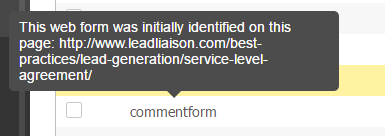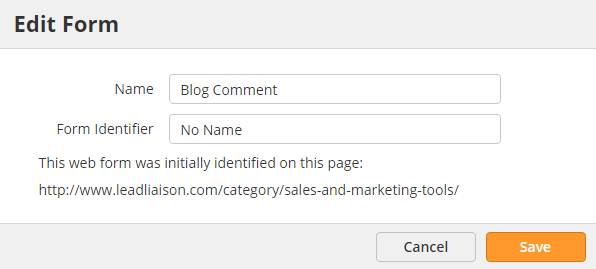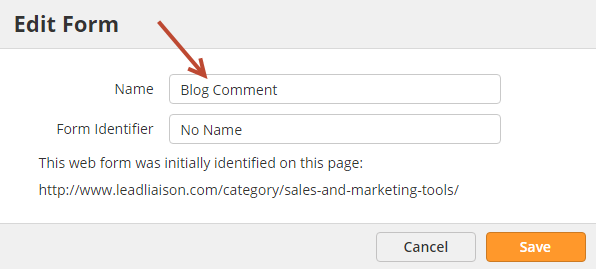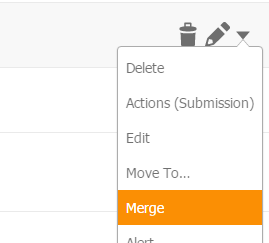Enables customers to automatically track website visitors who submit a form by their name, company and email. Additionally, leads are automatically created and optionally injected into supported CRM systems which reduces data entry time. All of this is done without adding anything else to your website except for 2-3 lines of tracking code.
This feature is called Automatic Web Form Tracking.
Supported Browsers
Browser | Version | Non-Ajax Forms | Ajax Forms |
|---|---|---|---|
Internet Explorer | IE8+ | Yes | Yes |
Firefox | 5+ | Yes | Yes |
Chrome | 13.0.782.112+ | Yes | Yes |
Opera | 11.5+ | Yes | Yes |
Safari | 5.1+ | No | Yes |
Lead Liaison automatically creates a "Tracked Form Object" for each webform with the same identifier. The identifier may be any of the following options, ordered by priority:
To see a list of automatically tracked webforms organized by Object do the following:
Lead Liaison automatically tracks email, name and company form fields. Web form fields with the following field names are automatically identified by Lead Liaison. The "name=" or "id=" parameter must be in one of the supported formats below. Lead Liaison will first check the name= parameter. If there's no match, then the id= parameter is used.
Field names are not case sensitive. For example, Email, email, eMAIL and EMAIL will all work. |
Email:
email, mail, mailaddress, emailaddress, mail_address, email_address, lead_email, leademail, contact_email, contactemail, lead_mail, leadmail, contact_mail, contactmail, your-email, contact.email, useremail, fields_email
Name:
name, fullname, full_name, leadname, lead_name, contactname, contact_name, your-name,
First Name:
firstname, first_name, fname, f_name, leadfname, lead_fname, contactfname, contact_fname, contact.firstname, first-name, userfirstname, fields_fname
Last Name:
lastname, last_name, lname, l_name, leadlname, lead_lname, contactlname, contact_lname, contact.lastname, contact.familyname, last-name, userlastname, fields_lname
Company:
company, companyname, company_name, organization, organizationname, organization_name, your-company, fields_business
Note, the default value for the ll_use_automatic_form_tracking JavaScript variable is true. In other words, removing this line var ll_use_automatic_form_tracking = true; or var ll_use_automatic_form_tracking = false; does not mean automatic web form tracking is disabled. When it's missing, it's still true. Follow the instructions below to set this variable to false. |
To turn off automatic web form tracking flip a flag in your tracking code. Change "true" to "false" in this line of your tracking code:
var ll_use_automatic_form_tracking = false; |
After changing the flag your tracking code should look similar to this:
<script type='text/javascript' language='javascript'>
var llcustid = 123456789;
var ll_use_automatic_form_tracking = false;
(function() {
var llt = document.createElement('script'); llt.type = 'text/javascript'; llt.async = true;
llt.src = 'https://t1.llanalytics.com/tracking_engine/lltc.min.php';
var s = document.getElementsByTagName('script')[0]; s.parentNode.insertBefore(llt, s);
})();
</script> |
The standard method for installing Lead Liaison's tracking code is to insert the JavaScript snippet into the footer of your website. However, when doing this it's impossible to manipulate the JavaScript snippet on the individual page, since it's included on the page from the global instantiation. To disable automatic tracking in this scenario, set the flag to false immediately after the standard JavaScript snippet. It's okay if the ll_use_automatic_form_tracking variable is still set to true or missing in the footer instantiation. Either of the code blocks below will work:
<script type='text/javascript' language='javascript'>
var llcustid = 123456789;
var ll_use_automatic_form_tracking = true;
(function() {
var llt = document.createElement('script'); llt.type = 'text/javascript'; llt.async = true;
llt.src = 'https://t1.llanalytics.com/tracking_engine/lltc.min.php';
var s = document.getElementsByTagName('script')[0]; s.parentNode.insertBefore(llt, s);
})();
</script>
<script var ll_use_automatic_form_tracking = false;></script> |
OR
<script type='text/javascript' language='javascript'>
var llcustid = 123456789;
(function() {
var llt = document.createElement('script'); llt.type = 'text/javascript'; llt.async = true;
llt.src = 'https://t1.llanalytics.com/tracking_engine/lltc.min.php';
var s = document.getElementsByTagName('script')[0]; s.parentNode.insertBefore(llt, s);
})();
</script>
<script var ll_use_automatic_form_tracking = false;></script> |
If it's not possible to set the flag to false immediately after the standard JavaScript snippet then make sure to remove this variable from the standard snippet. Do not leave it in the code snippet as var ll_use_automatic_form_tracking = true;. Remove that line all together. |
Identify where an automatically tracked web form was first found in one of two ways:



In the event a web form is not using one of Lead Liaison's auto-tracked web form fields you can still enable automatic web form tracking using one of three options:
If the form fields are something like:
Email <input type="text" name="field_1" /> Full Name <input type="text" name="field_2" /> Company <input type="text" name="field_3" /> |
Then use this custom JavaScript code with your tracking code:
var ll_fields_map_settings_by_field_name_identifier = {
email: 'field_1',
fullname: 'field_2',
firstname: '',
lastname: '',
company: 'field_3'
};
|
Your tracking code would be something like:
<script type='text/javascript' language='javascript'>
var llcustid = 123456789;
var ll_use_automatic_form_tracking = true;
var ll_fields_map_settings_by_field_name_identifier = {
email: 'field_1',
fullname: 'field_2',
firstname: '',
lastname: '',
company: 'field_3'
};
(function() {
var llt = document.createElement('script'); llt.type = 'text/javascript'; llt.async = true;
llt.src = 'https://t1.llanalytics.com/tracking_engine/lltc.min.php';
var s = document.getElementsByTagName('script')[0]; s.parentNode.insertBefore(llt, s);
})();
</script> |
If the form fields are something like:
Email <input type="text" id="field_id_1" /> First Name <input type="text" id="field_id_2" /> Last Name <input type="text" id="field_id_3" /> Company <input type="text" id="field_id_4" /> |
Then use this custom JavaScript code with your tracking code:
var ll_fields_map_settings_by_field_id_identifier = {
email: 'field_id_1',
fullname: '',
firstname: 'field_id_2',
lastname: 'field_id_3',
company: 'field_id_4'
};
|
Your tracking code would be something like:
<script type='text/javascript' language='javascript'>
var llcustid = 123456789;
var ll_use_automatic_form_tracking = true;
var ll_fields_map_settings_by_field_id_identifier = {
email: 'field_id_1',
fullname: '',
firstname: 'field_id_2',
lastname: 'field_id_3',
company: 'field_id_4'
};
(function() {
var llt = document.createElement('script'); llt.type = 'text/javascript'; llt.async = true;
llt.src = 'https://t1.llanalytics.com/tracking_engine/lltc.min.php';
var s = document.getElementsByTagName('script')[0]; s.parentNode.insertBefore(llt, s);
})();
</script> |
If the form fields are something like:
<div> <label for="field_id_1"> <span> Email </span> </label> <div> <input id="field_id_1" type="text" /> </div> </div> <div <label for="field_id_2"> <span> Company </span> </label> <div> <input id="field_id_2" type="text" /> </div> </div> <div> <label for="field_id_3"> <span> Full Name </span> </label> <div> <input id="field_id_3" type="text" /> </div> </div> |
Then use this custom JavaScript code with your tracking code:
var ll_fields_map_settings_by_field_label_for_identifier = {
email: 'Email',
fullname: 'Full Name',
firstname: '',
lastname: '',
company: 'Company'
};
|
Your tracking code would be something like:
<script type='text/javascript' language='javascript'>
var llcustid = 123456789;
var ll_use_automatic_form_tracking = true;
var ll_fields_map_settings_by_field_label_for_identifier = {
email: 'Email',
fullname: 'Full Name',
firstname: '',
lastname: '',
company: 'Company'
};
(function() {
var llt = document.createElement('script'); llt.type = 'text/javascript'; llt.async = true;
llt.src = 'https://t1.llanalytics.com/tracking_engine/lltc.min.php';
var s = document.getElementsByTagName('script')[0]; s.parentNode.insertBefore(llt, s);
})();
</script> |
If you have multiple forms with different names/identifiers across your website, then all form fields can be tracked using a single code snippet. Notice in the snippet below that all form field values are added, separated by commas.
var ll_fields_map_settings_by_field_name_identifier = {
email: 'field_1,field_2,field_3',
fullname: 'field_4,field_5,field_6',
firstname: '',
lastname: '',
company: 'field_7,field_8'
}; |
Depending on your selected method, your tracking code would be something like:
<script type='text/javascript' language='javascript'>
var llcustid = 123456789;
var ll_use_automatic_form_tracking = true;
var ll_fields_map_settings_by_field_name_identifier = {
email: 'field_1,field_2,field_3',
fullname: 'field_4,field_5,field_6',
firstname: '',
lastname: '',
company: 'field_7,field_8'
};
(function() {
var llt = document.createElement('script'); llt.type = 'text/javascript'; llt.async = true;
llt.src = 'https://t1.llanalytics.com/tracking_engine/lltc.min.php';
var s = document.getElementsByTagName('script')[0]; s.parentNode.insertBefore(llt, s);
})();
</script> |
If your form has an "onsubmit" event attribute then we'll monitor the response of this function when the prospect clicks the "submit" button. If the returning result of this event equals "false" we cancel handling the submission and do not send the data back to Lead Liaison.
In some cases, you may still want to have the "onsubmit" event to return false. For example, if the form is submitting data via Ajax. To accomodate this, you can override the option provided by Lead Liaison and Lead Liaison will still submit the data to our backend even if the original onsubmit event returns "false".
To enable this feature there are two options:
Option 1: Add an attribute to the form open tag as follows: ll_ignore_original_onsubmit_result="1"
![]()
Option 2: Add this flag to your tracking code: var ll_ignore_original_onsubmit_result = true;

If your form is submitted with Ajax and does not use the direct form submit action for submissions then follow these instructions.
Call the function below to trigger submitting the form after processing the submitted form on your backend. Lead Liaison will not be able to detect when the form is submitted until this function is called. Place the code below where your form submission is triggered.
If you built the form yourself you'll likely have an “onclick” event on the “submit” button at the bottom of the page.
If you are using a 3rd party form builder then the builder should give you an option to add JavaScript code to be called after the form submission.
// Use one of the two methods in Step 1 below. If neither of these options work for you then you can use any option that works for you to identify the form, such as with a name attribute or by a CSS class.
// Step 1) Identify the form:
// If the form has an "id" attribute:
var my_form = document.getElementById('form_id')
// If the form can not be defined by an "id", then use this method, knowing that the "0" below is the index of the form within all forms on the page. If the form has only one form then the code below will suffice.
var my_form = document.getElementsByTagName('form')[0]
// Step 2) Trigger Lead Liaison tracking code to track the form "my_form" submission:
_ll_track_form_submission.submit_form(my_form, function (){
// Insert any JavaScript code here that you want to apply after Lead Liaison completes processing the form submission.
}) |
If you have select web forms and prefer to have this additional tracking code only the pages where the web forms reside then place only the additional code snippet (similar to the example below) on the web page.
<script type='text/javascript' language='javascript'>
var ll_fields_map_settings_by_field_label_for_identifier = {
email: 'Email',
fullname: 'Full Name',
firstname: '',
lastname: '',
company: 'Company'
};
</script> |
Consider this use case, there is a web form with the following elements:
Email <input type="text" name="email" /> Full Name <input type="text" name="full_name" /> Company <input type="text" name="field_3" /> |
It's important to note the "Email" and "Full Name" fields will be automatically tracked without using any custom code since the field names are in a supported format by our Automatic Web Form Tracking technology. If this is the case, only add the code that pertains to the fields that are not automatically tracked such as in the example below:
var ll_fields_map_settings_by_field_name_identifier = {
company: 'field_3'
}; |
Make sure you're mindful of the behavior of this custom tracking code. For example, if you use it in a global header with something like:
var ll_fields_map_settings_by_field_name_identifier = {
email: 'field_1',
fullname: 'field_2',
firstname: '',
lastname: '',
company: 'field_3'
}; |
Then any web form within your website with these identifiers will be automatically tracked.
The custom code described in the section above may be added in any order within the block of Lead Liaison's JavaScript code. |
It might be necessary to merge one or more automatically tracked forms into a single auto-tracked form. Follow these steps to do that:

The merge will do the following:
Essentially, alerts and Fulfillment Actions on the destination form will not be removed or overridden; however, if there are no alerts and/or Fulfillment Actions on the destination form but they exist on the source form, then the alerts and/or Fulfillment Actions will be copied from the source to the destination.

If your web form is submitted in steps then you'll need to add an additional parameter to your tracking code where the multi-step form exists. In these cases, you might have a multi-step form wizard from a provider like Gravity Forms or your webform is custom built that uses JavaScript to override the "On Submit" event.
The parameter, called "ll_frequent_try_auto_track_forms", should be added only to your tracking code where the multi-step web form is located. Note: This method of tracking runs every 2 seconds. If the person submits the page where this parameter exists in less than 2 seconds the form will not be automatically tracked.
var ll_frequent_try_auto_track_forms = true; |
Please note this feature only works for automatically tracked webforms. It will not work with External Forms or Hosted Forms (including HTML embedded forms). Hosted forms have their own pre-fill capability in the web form designer. To learn more about web form types read this. |
The following fields can be pre-filled using this feature: email, company, first name, last name and full name. For pre-filling to work, the fields must be in the format described above on this wiki page. |
To turn form pre-fill on add the following line of code underneath your tracking code to each page that contains the form.
var ll_prefill_automatic_tracked_form_fields = true; |
Without this line of code form pre-fill will be disabled. By default, Lead Liaison will not pre-fill forms with business intelligence information (data retrieved from our geolocation and company identification lookups, or Hoovers - if enabled). To enable form pre-fill with business intelligence data add the following line of code:
var ll_prefill_form_with_ti_data = true; |